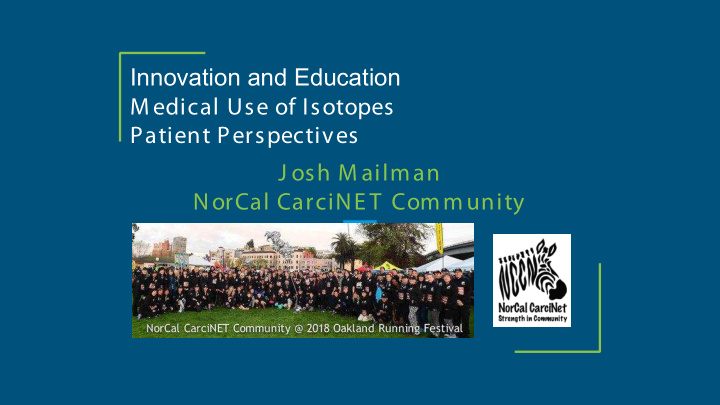



Innovation and Education M edical Use of Isotopes Patient Perspectives J osh M ailman NorCal CarciNET Community
Disclosure NorCal CarciNET receives funding for educational and speaking events from AAA, Curium, IPSEN, Lexicon, Novartis, and Progenics. Views expressed during this presentation are solely my own. Thank you on behalf of patients for this opportunity to participate in this forum
Who am I ? Diagnosed in 2007 with a Pancreatic Neuroendocrine Tumor ● First nuclear imaging in 2007 ● First Ga68 PET/CT in Germany 2008 ● First Nuclear Medicine Therapy in Germany 2009 Selected current affiliations: President - NorCal CarciNET Community COO - World Association of Radiopharmaceutical and Molecular Therapy Inaugural president of Patient Advocate Advisory Board and Ga68 Working Group- SNMMI Treasure and Board Member - Neuroendocrine Tumor Research Foundation
About Neuroendocrine Tumors (NETS) ● Considered a “Rare” or Orphan Disease ○ Low incidence ~7/100k ~21,000 ○ Second highest prevalence for GI Cancer ~172k ● Arising from cells of the endocrine (hormonal) and nervous systems. Yao, JCO ‘08 ○ They can occur all over the body ● Often hard to diagnose due to confusing symptoms and imaging challenges (more on that later) ● NETS overexpress naturally occurring somatostatin receptors
Approvals for Nuclear Medicine for NET Patients J une 2016, NETSPOT - Ga68 Dotatate for Imaging J anuary 2018, Lutathera - Lu177 Dotatate for Treatment of GEPNETS J uly 2018, Azedra - I131 - Para/Pheo J une 2019, Ga68 Dotatoc for imaging
Future Isotopes under Consideration We concur with the SNMMI, EANM and WARMTH on the promising use of Alpha emitters and Copper 67 for several disease indications beyond NETS ● Actinium-225 ( 225 Ac) * - α ● Lead-212 ( 212 Pb)* - α ● Copper-67 ( 67 Cu) - β ● Thorium-227 ( 227 Th) – α ● Terbium-149 ( 149 Tb) – α ● Bismuth-213 ( 213 Bi) – α ● Astatine-211 ( 211 At) - α
Patients Overjoyed with Availability ● Were desperately seeking any Ga 68 imaging since 2012 ● Facebook on NETSPOT approval generated over 100 comments on approval date ● Little understanding of the complexity of delivery ● Lutathera approval has allowed a therapeutic option availability that was limited to only those who could afford to travel overseas With Availability Comes New Opportunities for Education.
New Options in a New Era of Information ● Overwhelming response is positive to these approvals - but information challenges for patient, providers, and payers are magnified by the use of social media ● Concerns, confusion and misinformation regarding “Patient release instructions” ○ DIffers by treatment facility ○ Fear of the unknown with Radiation ○ Some families (and pets) are separated from each other for weeks ● Desire to work those that are trained are experienced with new drugs ○ Mis reads or mis understanding of imaging ○ Wanting to use an “experienced center” ● Challenge of getting this paid for All magnified in the lens of Facebook, and private patient support portals
Areas Where the Patient Release Criteria NRC Can Help Maintaining Education Standards Managing Regulatory Challenges
Patient Release Criteria NorCal CarciNET responded to Docket ID-NRC-2019-0154 Our response asked the NRC to consider adding isotope to tables 1 and 2 even if below threshold value with NA or “*” to indicate that the instructions do not apply as below threshold. Consider a patient friendly version of the Release Criteria so that patient can use this in discussion with their provider Confirm all values and best practice with stakeholders prior to final approvals
Training and Education Standards NorCal CarciNET Community responded to Docket ID NRC-2018-0230 in J anuary 2019. Our position was: 1. There is no shortage in the number of Authorized Users (AUs) for medical uses under 10 CFR 35.300. 2. There is adequate Geographic coverage of AUs where sufficient demand for therapy exists. 3. Current NRC regulations on AU Training & Education (T&E) requirements do not limit patient access to procedures involving radiopharmaceuticals. 4. Current NRC regulations on AU T&E requirements do not limit research and development in nuclear medicine. We are reviewing proposed rulemaking that was issued on 1-17-2020
Managing Regulatory Challenges We want to again thank the NRC for updating giudice in 2017 and again in 2019 in the matter of germanium-68/gallium-68 (Ge-68/Ga-68) pharmaceutical-grade generators We were involved in at least 2 calls over 2015/16 in regards to Ge68 being left of one table and the impact that might have to facilities that did not currently have a decommissioning plan in place. While we can not predict the next regulatory challenge we know that one will occur and steps to mitigate the resolution time should be considered
Thank You! J osh@ norcalcarcinet.org
Recommend
More recommend